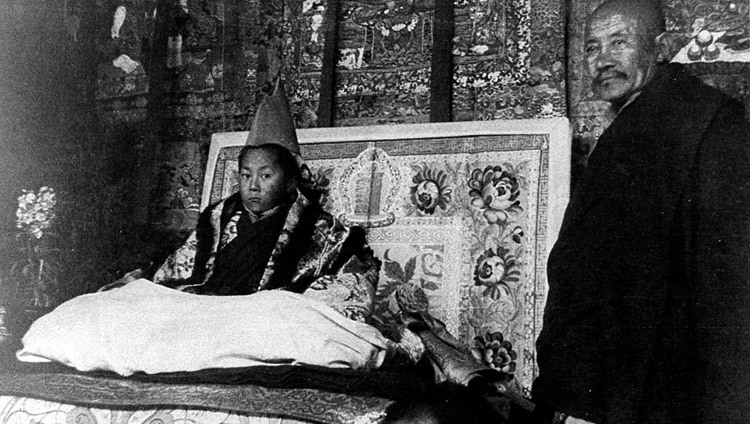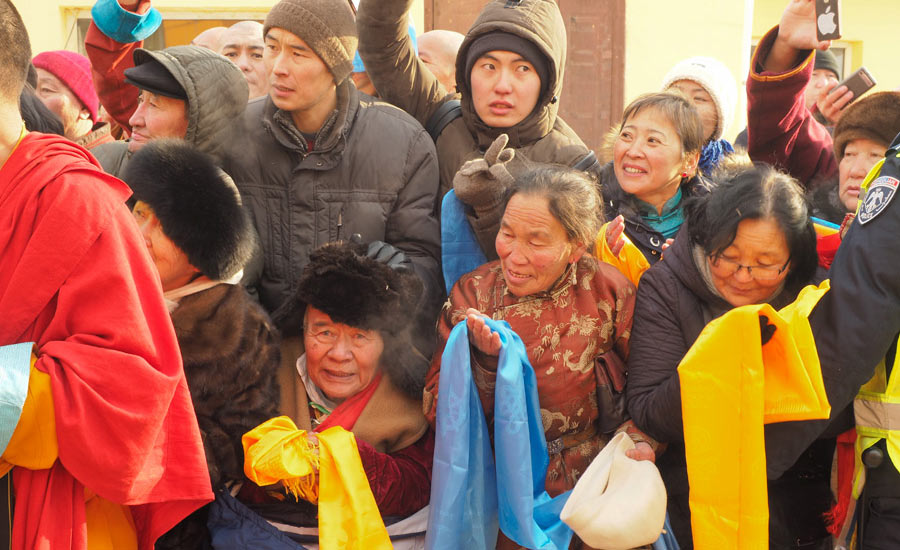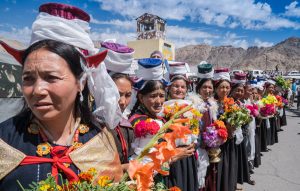
The four-year-old Dalai Lama glances at the camera during his enthronement ceremony in Lhasa, Tibet on Feb. 22, 1940
In fact, when I took my job with the International Campaign for Tibet two summers ago, my first thought was that after about a decade as a professional, I’d finally made it in the world. That had nothing to do with money (the public sector is not exactly a goldmine) or reputation (I had been working for the Pew Charitable Trusts, a household name among nonprofits) or even the type of work I do here (which is pretty much the same as what I’ve done in past jobs). Instead, it had everything to do with His Holiness the Dalai Lama and what he represents.
Tomorrow, the world will celebrate 80 years since the enthronement of this icon from Tibet. On Feb. 22, 1940, the four-year-old Dalai Lama officially took the throne in a glorious ceremony at the Potala Palace in the Tibetan capital of Lhasa. The photo above provides an extraordinary glimpse at the child who—according to Tibetan Buddhist beliefs—is an incarnation of Avalokiteśvara, a Bodhisattva of compassion, and who, unlike his 13 predecessors, would go on to bridge the gap between Tibet’s unique culture and the outer world while leading his people and their supporters in an epochal moral and political struggle against the Chinese Communist Party.
I am not the most qualified person to deliver a biography of His Holiness, nor am I in a position to offer a rigorous study of his religious and philosophical ideas. Instead, I plan to use this post to share some personal reflections on what the Dalai Lama has done for me, a non-Tibetan living in the West whose almost entire life has been limned by the gentle glow of his wisdom and beneficence.
Little Dalai Lama
I cannot say when I first learned of the Dalai Lama, but my earliest intact memories of him date back to when we were both kids—sort of. In 1997, two major films came out that focused on the early life of His Holiness: “Seven Years in Tibet,” starring Brad Pitt as the Austrian mountain climber Heinrich Harrer, and “Kundun,” directed by Martin Scorsese. (This was back before China managed to almost completely censor any mention of Tibet in Hollywood.) Watching those movies with my father helped familiarize me with Tibet and the ongoing human rights crisis there.
I can recall having two distinct emotional reactions to “Seven Years in Tibet” and especially “Kundun.” The first was that I felt sorry for the little boy Dalai Lama, because I was a kid too, and I thought it must have been so boring for him to spend all his time indoors meditating, rather than going outside to play. To me, it was like having to go to church every day.
My other reaction was pride in knowing that His Holiness eventually took refuge in India. Although I had no real memories of India, I knew that I was born there and that I was Indian, so I thought it was pretty cool that this revered world leader lived in my homeland. Today, that immature sense of ethnic self-satisfaction has been replaced by my appreciation for His Holiness’ role as a spokesperson for ancient Indian philosophy. The Dalai Lama often now talks about his commitment to reviving India’s traditional knowledge, especially the teachings of the Nalanda Buddhist academy and the Indian masters’ understanding of psychology and mental training—things I too think are urgently needed for curing the modern world’s spiritual and psychic maladies.
Nonviolence
It’s no surprise, then, that my next vital memory of the Dalai Lama’s influence in my life involves another Indian sage. When I was a freshman in college and trying to sort out my political views, my roommate had me take a political compass test that placed my beliefs along X and Y coordinates on a plot graph that also charted the ideology of famous figures. If I recall correctly, my roommate ended up in the quadrant of the graph that had Karl Marx and Che Guevara, but that didn’t seem quite right for me. Thankfully, the quadrant my beliefs landed me in was home to His Holiness and to Mahatma Gandhi—two great avatars of nonviolence and moral resistance.
A few months ago, I wrote another post for this blog touching on His Holiness’ affinity for the Mahatma and drawing comparisons between the movements these two wise men have led. Most significant to me was the fact that neither Gandhi nor the Dalai Lama are revolutionaries or freedom fighters in the most commonly understood meanings of those terms. Gandhi never wanted India to become a contemporary nation like its colonial ruler, Great Britain. Rather, he dreamed of an India that would repudiate modern civilization and embrace traditional notions of simplicity, neighborliness, local self-rule and nonviolence. Similarly, the Dalai Lama has even been willing to accept less than total independence for Tibet in favor of a Middle Way Approach of genuine autonomy and mutual benefit with the Chinese. He has also, to my immense satisfaction, guided Tibetans in exile to adopt democracy and relinquished his own political authority.
No need to worry
My youthful sense of identification with the Dalai Lama was a source of background comfort through the first quarter-century of my life, but it was not until just under a decade ago that I really began to look more closely at his beliefs. At the time, I was going through the kind of existential confusion common to people in that age group. I had drifted away from my childhood religion (Christianity), I had struggled to find my place in the world in my first few years out of college, and I felt profound anxiety and uncertainty over my future.
During that period, I began to gravitate toward Buddhism, which presented me with a radically different understanding of the world and the self than the one I had been raised with. Of course, the Dalai Lama is likely the world’s most famous Buddhist, so he quickly emerged as my go-to source of guidance, as well as my biggest hero. Through my fervent consumption of his YouTube clips (my favorite was this one where he laughs uncontrollably at an Australian reporter’s unsuccessful attempt to tell a joke; I challenge any of you to watch it without giggling) and his pithy sayings, His Holiness quickly became the most prophetic voice in this world reminding me that life is actually good. I even went so far as to tape a small postcard of the Dalai Lama to the side of my dresser, so that when I was getting ready in the morning, I could see his beaming smile and remember to embody his teachings as I went about my day.
That summer, 2011, I saw—for the only time so far in my life—the Dalai Lama in person when he spoke outside the US Capitol here in Washington, DC. I will never forget that I went there that day with a slightly older friend of mine who tragically died just a few years later from an unexpected health issue. Thus my memories of this friend, who was a person of deep compassion, will forever be intertwined with my memories of seeing the Dalai Lama, which seems fitting.
A couple years after that day at the Capitol, when the brilliance of the Dalai Lama’s beliefs had begun to take root in my mind, I shared with another close friend of mine my favorite quote from His Holiness, which by then had become my words to live by:
“If you have fear of some pain or suffering, you should examine whether there is anything you can do about it. If you can, there is no need to worry about it; if you cannot do anything, then there is also no need to worry.”
Today and tomorrow
Today, I feel blessed to be part of the Tibet movement, because I always knew I wanted to try to do something good for the world, but I never could have guessed I would get to do something as good as serve the vision of His Holiness.
As China pursues its wicked plans to appoint the Dalai Lama’s eventual successor, it is more important than ever for all of us to take action to protect the legacy and the teachings of this great man.
I hope you will join me tomorrow in celebrating the 80th anniversary of His Holiness’ enthronement. And, if you have not already done so, please write to your Senators to ask them to support the Tibetan Policy and Support Act, which will make it official US policy that only Tibetan Buddhists can decide the Dalai Lama’s succession—and will sanction any Chinese officials who attempt to name their own Dalai Lama in the future.


